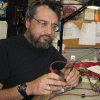
Favorite locomotives of mine
I have a favorite of each type of locomotive: steam, electric and diesel. They are the Southern Pacific GS-4 class Northern (4-8-4) wheel arrangement, the ALCo PA-1 diesel, and the PRR's GG-1 electric.
This photos was taken in my back yard and on a diorama that I built for taking such photos. The only post processing that was done was to crop out the lower portion that showed the unfinished lumber of the diorama.
Models used are as follows. Broadway Limited Imports - GS-4; Life-Like Proto 2000 - ALCo PA-1; AHM - GG-1. All models are H-O scale.
While I do have a model of a PRR PA-1 I feel that the Daylight scheme does the loco justice; and the GG-1 is in its as delivered Brunswick Green, though weathered, with 5 pinstripe scheme.
This photos was taken in my back yard and on a diorama that I built for taking such photos. The only post processing that was done was to crop out the lower portion that showed the unfinished lumber of the diorama.
Models used are as follows. Broadway Limited Imports - GS-4; Life-Like Proto 2000 - ALCo PA-1; AHM - GG-1. All models are H-O scale.
While I do have a model of a PRR PA-1 I feel that the Daylight scheme does the loco justice; and the GG-1 is in its as delivered Brunswick Green, though weathered, with 5 pinstripe scheme.
Category All / Still Life
Species Unspecified / Any
Size 1280 x 637px
File Size 149.9 kB
I went old school to take close-up shots of the locos. I dug out my Chinon CE-4 35mm SLR and got some decent, I hope, 3/4 shots of the locos. I used a Tuscan red G instead of the Brunswick green one. I want to take some more photos with the camera to use the rest of the film, so it might take a while to get the roll developed.
To clarify; buffers are the spring loaded over-sized "thumbtacks" on the ends of the locos and cars. They are mounted, IIRC, on buffer plates. The U. S. never went to them because we got rid of chain coupling pretty early. We went from chain to link and pin. A link was like an over sized chain link and was held in place by two pins. There wasn't much space between the cars, and it as a dangerous job to couple cars together. Many men lost fingers, hands and their life due to the link and pin. Then Col. Janney developed the "hand clasp" coupler, the derivatives we still use today, though we now call them "knuckle" couplers. Congress made the handclasp coupler mandatory pretty quickly, due to the dangerous nature of the link and pin. With the hand clasp coupler along with George Westinghouse's air brake system, which was required by law, the need for European style buffers never materialized.
This is not say we do not use buffers in the U. S., as we do on a small scale. The device mounted just above the coupler on the PA-1 is a buffer, and they are used on passenger cars to close the floor gap in the diaphragms.
The term "pilot" is a hold over from the steam days. While the term "cow catcher" was/is used, the proper term is pilot. The front wheels under a steam locomotive is called a pilot truck. Actually, I think the U.S. terminology makes more sense in the long run. We started with "brigades of cars" which very shortly became a "train". We do use the term "bogie" for the wheel-axle assembly, but more often it is called a "truck".
You folks in Oz held on to your relationship with the queen much longer than us Yanks did, that's why you tend to use Queen's English terms instead of American English terms. As I always say, "Here, in the U.S., we don't speak English, we speak American." It is, at times, a totally different language than English English.
To clarify; buffers are the spring loaded over-sized "thumbtacks" on the ends of the locos and cars. They are mounted, IIRC, on buffer plates. The U. S. never went to them because we got rid of chain coupling pretty early. We went from chain to link and pin. A link was like an over sized chain link and was held in place by two pins. There wasn't much space between the cars, and it as a dangerous job to couple cars together. Many men lost fingers, hands and their life due to the link and pin. Then Col. Janney developed the "hand clasp" coupler, the derivatives we still use today, though we now call them "knuckle" couplers. Congress made the handclasp coupler mandatory pretty quickly, due to the dangerous nature of the link and pin. With the hand clasp coupler along with George Westinghouse's air brake system, which was required by law, the need for European style buffers never materialized.
This is not say we do not use buffers in the U. S., as we do on a small scale. The device mounted just above the coupler on the PA-1 is a buffer, and they are used on passenger cars to close the floor gap in the diaphragms.
The term "pilot" is a hold over from the steam days. While the term "cow catcher" was/is used, the proper term is pilot. The front wheels under a steam locomotive is called a pilot truck. Actually, I think the U.S. terminology makes more sense in the long run. We started with "brigades of cars" which very shortly became a "train". We do use the term "bogie" for the wheel-axle assembly, but more often it is called a "truck".
You folks in Oz held on to your relationship with the queen much longer than us Yanks did, that's why you tend to use Queen's English terms instead of American English terms. As I always say, "Here, in the U.S., we don't speak English, we speak American." It is, at times, a totally different language than English English.
Some important dates in U. S. railroad history:
First "road of rails": 1795 in Boston, Mass.
First railway charter: 1815 for a railroad between New Brunswick and Trenton, NJ. This now part of Amtrak's North East Corridor. Yes, it is that old.
First common carrier railroad: The Baltimore and Ohio railroad on Jan. 7, 1830
Air brake development: George Westinghouse patented the device in 1869 and an improved "plain automatic brake: in 1872.
Automatic Coupler: Test started by the Master Car Builders Association (M.C.B.) in 1869, with important test in September of 1885. In 1887 the M.C.B. approved Major (not Col.) Eli H. Janney's vertical plane coupler (aka knuckle coupler).
So with those dates you can see that development of the air brake and automatic coupler happened relatively quickly after the first common carrier was formed; just a bit over 50 years.
First "road of rails": 1795 in Boston, Mass.
First railway charter: 1815 for a railroad between New Brunswick and Trenton, NJ. This now part of Amtrak's North East Corridor. Yes, it is that old.
First common carrier railroad: The Baltimore and Ohio railroad on Jan. 7, 1830
Air brake development: George Westinghouse patented the device in 1869 and an improved "plain automatic brake: in 1872.
Automatic Coupler: Test started by the Master Car Builders Association (M.C.B.) in 1869, with important test in September of 1885. In 1887 the M.C.B. approved Major (not Col.) Eli H. Janney's vertical plane coupler (aka knuckle coupler).
So with those dates you can see that development of the air brake and automatic coupler happened relatively quickly after the first common carrier was formed; just a bit over 50 years.
Yes, I am very proud to adhere to the Queen's english.
Australia has nearly always been deplorably slow to adopt new technology (just look at the cost of internet use here). There were still instances of chain-link coupling rolling stock in use into the early 1980's, albeit rare by then. (I was astounded when I saw automatic couplings on the 1885 period locomotive in Back to the Future III, and disgusted with Australia when I realised the implication). To facilitate this many of our diesel locomotives were built with interchangeable couplings. You can see that my all-time favorite locomotive has a very attractive buffer arrangement. http://www.furaffinity.net/view/9333532/ Once the last chain-link rolling stock was finally decomissioned buffers ceased to be built on new locomotives and many existing locomotives had them removed. I don't know which locomotive in New South Wales was the first to be built with no buffers (probably the 81 class), but they were on all from the 40 class through to at least the 48 class (including the 422 and 442). Wikipedia hasn't been much help to me there, as most of the photographs show the locomotives in the newest colour schemes and with the buffers already removed. Hmph! All those articles ought to show the locomotives in their birthday colours.
Australia has nearly always been deplorably slow to adopt new technology (just look at the cost of internet use here). There were still instances of chain-link coupling rolling stock in use into the early 1980's, albeit rare by then. (I was astounded when I saw automatic couplings on the 1885 period locomotive in Back to the Future III, and disgusted with Australia when I realised the implication). To facilitate this many of our diesel locomotives were built with interchangeable couplings. You can see that my all-time favorite locomotive has a very attractive buffer arrangement. http://www.furaffinity.net/view/9333532/ Once the last chain-link rolling stock was finally decomissioned buffers ceased to be built on new locomotives and many existing locomotives had them removed. I don't know which locomotive in New South Wales was the first to be built with no buffers (probably the 81 class), but they were on all from the 40 class through to at least the 48 class (including the 422 and 442). Wikipedia hasn't been much help to me there, as most of the photographs show the locomotives in the newest colour schemes and with the buffers already removed. Hmph! All those articles ought to show the locomotives in their birthday colours.
Well, the movies may not be totally historically accurate when it comes to such things as railroad safety equipment. There is no way that the FRA (Federal Railroad Administration) would allow working link and pin couplers to be used on active rolling stock, short of decorative ones on the pilots of Civil War era steam locomotives.

 FA+
FA+








Comments